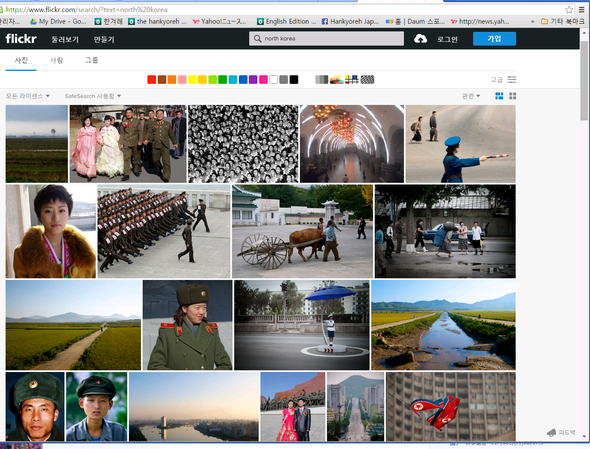hankyoreh
Links to other country sites 다른 나라 사이트 링크
[Reporter’s notebook] On Flickr, a chance to see the non-aggressive North Korea

Vivid, yet strange.
Looking at pictures taken by travelers to North Korea on Flickr is an experience that evokes conflicting emotions.
Run by Yahoo, Flickr is counted alongside Instagram as one of the leading photo-sharing sites around. Most of its images are travel pictures. But recent years have seen a marked increase in photos taken around North Korea. Typing the keyword “North Korea” in its search box on Nov. 25 brought up a message reporting 145,813 results.
The increase in North Korea pictures has been especially visible since Kim Jong-un took over as leader in 2012. Indeed, it may be linked to his emphasis on promoting the country’s travel industry. Newer, more generous standards on picture-taking also look to have been established to help draw visitors. During my ten or so visits during the early ‘00s, photographing farming regions was strictly forbidden; this time, such images were easy to find on Flickr. Uwe Brodrecht, a German traveler who visited North Korea between Oct. 5 and 15, posted images that he had actually taken inside of farming homes when he stopped in villages like Chonsam in Kangwon Province’s Anbyon County.
What kind of effect could this proliferation of pictures on Flickr and elsewhere have on inter-Korean relations? From my perspective, I think the impact will most likely be positive. In particular, they could become a means of replacing our rigidified views on North Korea with something a bit more realistic.
In the past, the media in both South and North Korea has chiefly documented images of their border region and the armistice line. Those images of “our troops,” heavily armed and guarding the line, have functioned for both sides to make the other appear belligerent. Even when the border hasn‘t been the focus, the media on either side of it have typically opted for photos of military reviews or other imagines intended to make the other side look aggressive.
People in both South and North Korea have generally only seen the other side through these cherry-picked images. As a result, they have tended to view people there as more extreme than they actually are. The more extreme this image of the other gets, the further away our chances for inter-Korean peace drift. Even when one side works toward peace, the other side is more likely to see that as dissembling to conceal its true violent nature.
The images of North Korea that appear on Flickr differ from the stereotypes. They provide vivid glimpses of people living their everyday lives: a group waiting at a bus stop in Pyongyang, students riding their bikes to school, couples chatting by the Taedong River, pedestrians stopping to look at a big electronic display in front of Pyongyang Station, stylish young women in high heels and sunglasses, even little girls dressed in Hello Kitty raincoats. The sense they give us is that even with the differences in economic level, their day-to-day lives are not all that different from ours.
Those vivid images do also come across as strange. The places that appear in them appear different from the North Korea we know. Maybe it’s the stereotypes that remain deeply embedded in our minds.
In my view, the chances for inter-Korean reconciliation will only grow when more and more people look at those Flickr pictures and start shaking off the strangeness to see them for their vividness. I look forward to seeing more of these new, vivid images of North Korea on Flickr in the days ahead.
By Kim Bo-geun, senior staff writer
Please direct questions or comments to [english@hani.co.kr]

Editorial・opinion
![[Column] Has Korea, too, crossed the Rubicon on China? [Column] Has Korea, too, crossed the Rubicon on China?](https://flexible.img.hani.co.kr/flexible/normal/500/300/imgdb/original/2024/0419/9317135153409185.jpg) [Column] Has Korea, too, crossed the Rubicon on China?
[Column] Has Korea, too, crossed the Rubicon on China?![[Correspondent’s column] In Japan’s alliance with US, echoes of its past alliances with UK [Correspondent’s column] In Japan’s alliance with US, echoes of its past alliances with UK](https://flexible.img.hani.co.kr/flexible/normal/500/300/imgdb/original/2024/0419/2317135166563519.jpg) [Correspondent’s column] In Japan’s alliance with US, echoes of its past alliances with UK
[Correspondent’s column] In Japan’s alliance with US, echoes of its past alliances with UK- [Editorial] Does Yoon think the Korean public is wrong?
- [Editorial] As it bolsters its alliance with US, Japan must be accountable for past
- [Guest essay] Amending the Constitution is Yoon’s key to leaving office in public’s good graces
- [Editorial] 10 years on, lessons of Sewol tragedy must never be forgotten
- [Column] A death blow to Korea’s prosecutor politics
- [Correspondent’s column] The US and the end of Japanese pacifism
- [Guest essay] How Korea turned its trainee doctors into monsters
- [Guest essay] As someone who helped forge Seoul-Moscow ties, their status today troubles me
Most viewed articles
- 1[Column] The clock is ticking for Korea’s first lady
- 2After 2 months of delayed, denied medical care, Koreans worry worst may be yet to come
- 3[Column] Has Korea, too, crossed the Rubicon on China?
- 4Samsung barricades office as unionized workers strike for better conditions
- 5All eyes on Xiaomi after it pulls off EV that Apple couldn’t
- 6[Correspondent’s column] In Japan’s alliance with US, echoes of its past alliances with UK
- 7US overtakes China as Korea’s top export market, prompting trade sanction jitters
- 8Hong Se-hwa, voice for tolerance whose memoir of exile touched a chord, dies at 76
- 9[Photo] Smile ambassador, you’re on camera
- 10[Editorial] When the choice is kids or career, Korea will never overcome birth rate woes